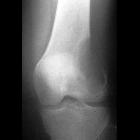erworbenes Cholesteatom










Acquired cholesteatomas makeup 98% of all middle ear cholesteatomas and are almost always closely related to the tympanic membrane, from which most are thought to arise.
Clinical presentation
The vast majority of acquired cholesteatomas develop as a result of chronic middle ear infection and are usually associated with perforation of the tympanic membrane. Clinical presentation usually consists of conductive hearing loss, often with purulent discharge from the ear .
Patients may also present due to one of many complications, which include:
- labyrinthine fistula (perilymphatic fistula)
- cochlear fistula: less common
- labyrinthitis
- facial nerve dysfunction including the rare inflammatory neuroma of the facial nerve
- extension through inner ear into internal acoustic meatus leading to deafness
- extension into the middle cranial fossa with possible meningitis, cerebral abscess, etc.
- extension into the petrous apex (rare) with similar complications to petrous apicitis
Pathology
Cholesteatomas are composed of densely packed desquamated keratinizing squamous cells, arising from a peripheral shell of inward-facing epithelium. As cells mature, they continue to be shed into the mass, resulting in slow growth .
There are four hypotheses that relate to the formation of cholesteatomas; all may be true :
- invagination/negative pressure
- probably the most common cause
- results from Eustachian tube dysfunction and tympanic membrane retraction, with debris and keratin eventually obstructing the neck of the retraction
- invasion/migration
- in the setting of a previous perforation
- keratinized cells 'invade' the middle ear through the perforation
- basal cell hyperplasia and papillary ingrowth
- invasive hyperplasia of the basal cell layer of the tympanic membrane as a result of infection
- metaplasia
- as a result of chronic irritation from middle ear infection
Radiographic features
CT
CT is the modality of choice for diagnostic assessment of cholesteatomas, due to its ability to demonstrate the bony anatomy of the temporal bone in exquisite detail. Cholesteatomas appear as regions of soft-tissue attenuation, exerting mass effect and resulting in bony erosion.
Findings depend on the part of the tympanic membrane the cholesteatoma arises from:
- pars flaccida (82%)
- superior extension: most common, it expands into Prussak space, eventually eroding the scutum and displacing the ossicles medially
- inferior extension: less common, but more frequently seen in children
- pars tensa
MRI
Although MRI is unable to adequately delineate bony anatomy, it can potentially distinguish non-specific opacification from cholesteatomas. It is particularly useful in the postoperative setting when CT may be indeterminate, since granulation tissue, scarring and recurrent cholesteatoma may all appear similar .
Cholesteatomas demonstrate:
- T1: low signal
- T2: high signal
- T1 C+ (Gd): no enhancement
- DWI: diffusion restriction
Diffusion-weighted imaging is particularly useful when distinguishing a cholesteatoma from other middle ear masses. It is the only entity that demonstrates high signal intensity on DWI. However, the sequence is prone to artefact and care must be taken how the sequence is performed and interpreted . Non-echo planar DWI is superior for the diagnosis of cholesteatoma and is therefore preferred if it is available . DWI (especially non-EPI DWI) is particularly useful in cases of suspected post-surgical recurrence.
The mechanism responsible for a high signal on DWI remains somewhat uncertain but is thought to represent either T2 shine-through alone or in combination with true restricted diffusion .
Treatment and prognosis
Surgical excision is curative. However, recurrence is not uncommon because the lesion is often difficult to remove completely.
Differential diagnosis
The differential of a middle ear mass includes:
- cholesterol granuloma
- high T1 signal
- no enhancement
- no restriction diffusion
- mucoid impaction
- glomus tympanicum
- facial nerve schwannoma
Post-operative
Following resection of a cholesteatoma, the differential for a soft-tissue middle ear mass includes the entities above, but is usually restricted to three entities :
- recurrent cholesteatoma
- high T1 signal
- no enhancement
- increased signal on DWI
- granulation tissue
- intermediate T1 signal
- enhancement
- low signal on DWI
- scarring
- low T1 and T2 signal
- low signal on DWI
Siehe auch:
- Cavum tympani
- Cholesterolgranulom der Felsenbeinspitze
- Cholesteatom
- Chordom
- Schwannom
- chronische Otomastoiditis
- Paragangliom
- Chondroblastom
- Riesenzelltumor
- epidermale Inklusionszyste
- Cholesteatom des äußeren Gehörgangs
- Histiozytose X
- Metastase
- congenital cholesteatoma
- Schwannom des Nervus facialis
- Primitiver neuroektodermaler Tumor
und weiter:

 Assoziationen und Differentialdiagnosen zu erworbenes Cholesteatom:
Assoziationen und Differentialdiagnosen zu erworbenes Cholesteatom:













